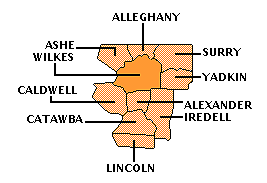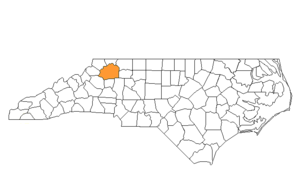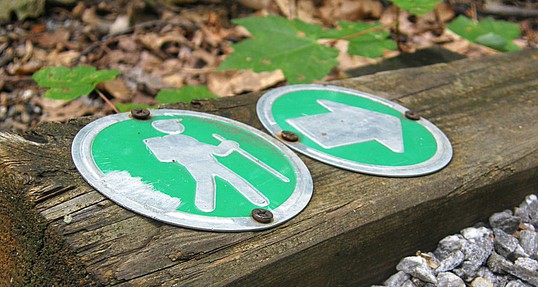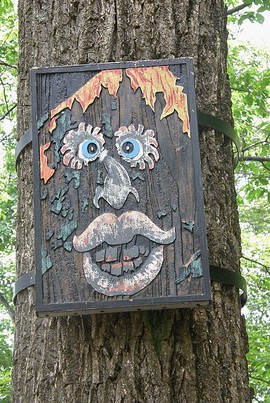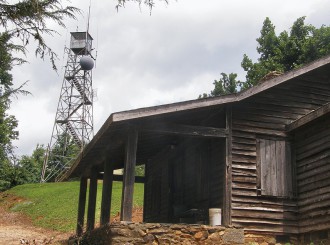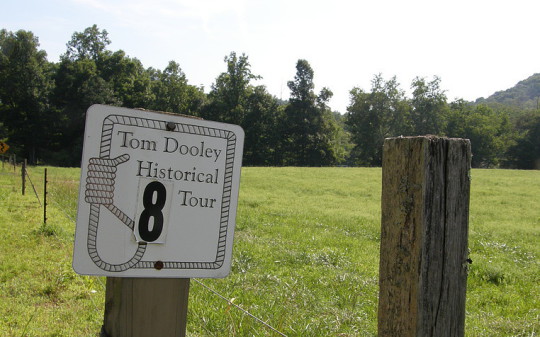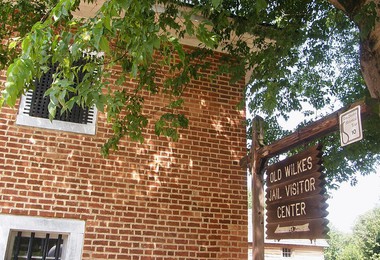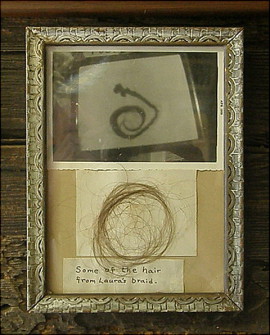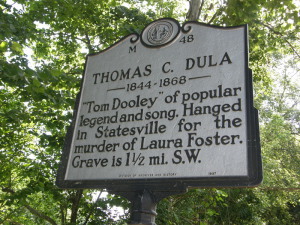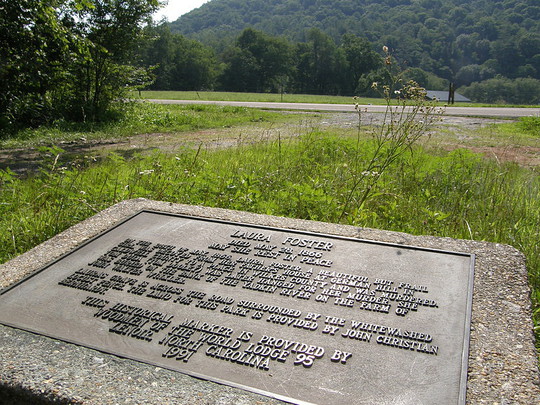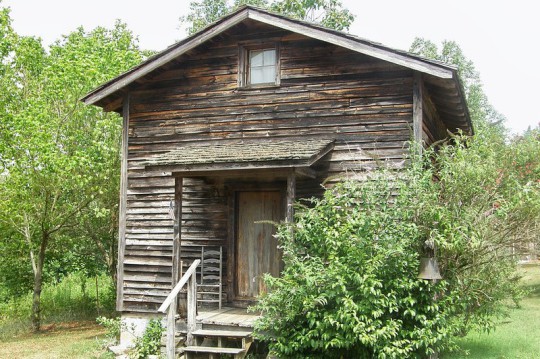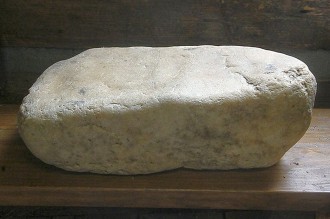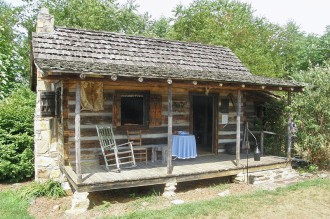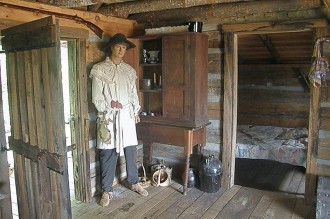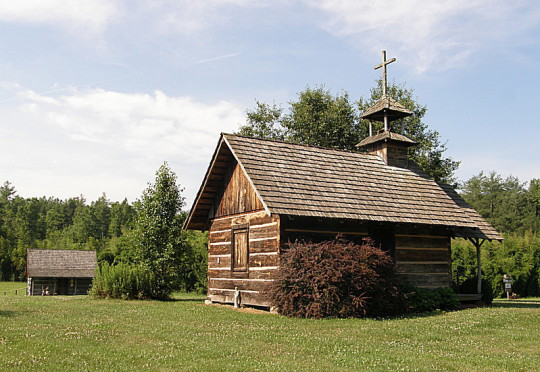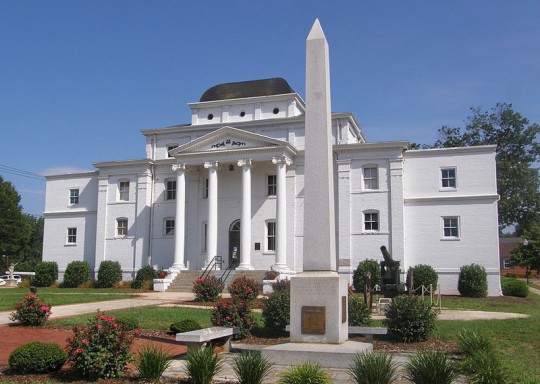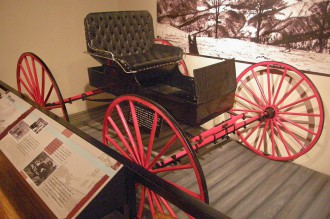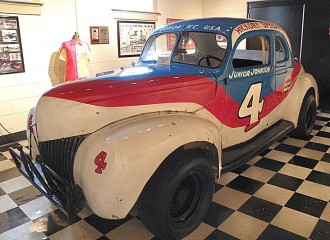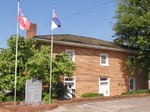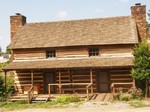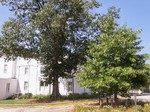WILKES COUNTY
Scroll down this page or click on specific site name to view features on the following Wilkes County attractions/points of interest:
Rendezvous Mountain Educational State Forest, Tom Dooley Trail, Whippoorwill Academy & Village, Wilkes Heritage Museum, Blue Ridge Music Hall of Fame
Fast facts about Wilkes County:
Created in 1777, the county is named for John Wilkes, an English journalist and politician who supported American independence.
The county seat is Wilkesboro. Other communities include Austin, Ferguson, Millers Creek, Moravian Falls, and North Wilkesboro.
Wilkes County’s land area is 757.19 square miles; the population in the 2010 census was 69,340.
It is noteworthy that Tom Dula (Dooley), the subject of a popular folksong, was a resident of Wilkes County.
Below: A new black oak tree stands behind the old Wilkes County Courthouse in tribute to the original "Tory Oak" which gained famed during the American Revolution
Northwest of Wilkesboro
Rendezvous Mountain Educational State Forest, just a few miles northwest of Wilkesboro, is a choice place to have an out-of-the-way get-together with Mother Nature. Nestled in the Blue Ridge Mountains, the state-managed forest includes slightly more than 3,300 acres, of which the main area for public use covers 146 acres. Highlights include the Talking Tree, Logging History, and Forest Demonstration Trails and the educational cabin, along with splendid picnic facilities and inspiring scenic views.
The North Carolina system of educational state forests includes six centers statewide. These managed forests are essentially outdoor classrooms, teaching visitors about the complex ecosystems which comprise a forest and intended to help them gain a better understanding and appreciation of forests. One means of educating the public is the child-oriented Talking Tree Trail, a .6 mile, modestly strenuous path that loops its way through a stand of towering mountain hardwoods, including red maple, yellow poplar, white oak, and hickory. It takes 35-45 minutes to walk the trail. Seven selected trees have wooden faces mounted to them, with recorded messages available for play. The trees have names, speak in the “first person,” and tell visitors about themselves, their surroundings, and general history about the forest itself. Aimed at kids, it’s educational for adults as well. If the Talking Tree Trail is
designed to appeal to young-sters, the Logging History Trail has a much to of interest for adults. Along this path guests will see a well-furnished saw miller’s cabin, a mule-drawn logging “bump” cart, and an au-thentic 19th century saw mill. In addition to audio recordings at each of these exhibits, there are many illustrated signs spaced out along the trail to explain some of the basics of forestry: how trees actually grow; how a devise known as the Biltmore stick is used to measure how much wood is in a tree; how logs are cut at the mill to maximize their yield; and so on.
The educational cabin displays dozens of mounted animals and birds native to the area. Raccoons and rabbits are represented, along with deer, beavers, and groundhogs. Mounted ground predators include a bobcat, a fox, and even an adult wolf. Numerous birds of prey are also exhibited. A short trail behind the educational building leads past an old Civilian Conservation Corps cabin left over from the 1930s up to the fire tower. Elevation at this point is 2,500 feet above sea level. The tower itself, of course, is not open for climbing. The site is equipped with modern restroom facilities, a large group picnic shelter, and many individual picnic areas with tables and grills, most providing scenic views of the surrounding countryside. Driving west from Wilkesboro on US 21, turn right onto NC 16. Turn left onto Boone Trail, right onto Shingle Gap Road, then left onto Rendezvous Mountain Road, which is a gravel road until you reach the entrance to the forest. Rendezvous Mountain is open from the third Wednesday in March until the Friday after Thanksgiving. Call the office for daily opening and closing hours and for information about ranger-conducted classes for groups of ten or more. 336-667-5072
Wikesboro, Ferguson and vicinity
More than a half-century ago, back in 1957, The Kingston Trio lent their voices to an old folk tune and turned “Hang Down Your Head, Tom Dooley” into a chart topper. The song is still popular today, but few of its listeners likely know that the subject of the song, Thomas Dula, lived right here in North Carolina, and that the crime for which he was found guilty – the murder of supposed sweetheart Laura Foster – took place around the Elkville/Ferguson community in Wilkes County. Those interested in the story behind the folk song can spend a few hours on NC highway 268 between Lenoir and Wilkesboro – designated an NC Scenic Byway – and make some stops along the informal "Tom Dooley Trail.”
An obvious place to begin following the footsteps of Tom Dooley would be at the Wilkes County Heritage Mus-eum in Wilkesboro. Located in the former 1902 courthouse build-ing, the Museum has much to attract visitors, but it’s the old brick jail out back that holds special interest for those wanting to delve into the Dooley story. It was here that the Civil War veteran was first incarcerated after his capture in Tennessee. Anne Melton, another of Dooley’s love interests and also implicated in the murder of Laura Foster, was held for several months in an adjoining second floor cell. After visiting the jail and county museum, head southwest on NC highway 268 toward Ferguson.
Just east of the Yadkin River is Whippoorwill Village, a collection of buildings brought together through the efforts of retired art teacher Edith Ferguson Carter. The original Whippoorwill school house is here, along with a chapel, Daniel Boone replica cabin, an old country store, and other buildings. Most importantly, the site includes the Tom Dooley museum, where you’ll see many interesting mementos. No photos exist of Tom Dooley, but we learn from the oath of allegiance he took at the end of the Civil War that he had light completion, brown eyes, and stood 5 feet, 9 ½ inches. There are no pictures of Laura Foster, either, but there is a grainy image of Anne Melton, a picture of defense counselor Zebulon Vance, and photos of many other individuals who were associated in the case in one way or another. Among other curios are a lock of Laura’s hair and the original gravestone that once marked Dooley’s grave. Having been raised in the community, Edith Carter often heard the stories about Tom Dooley from family and friends during her childhood, and when the Kingston Trio’s song rekindled interest, she was inspired to do a series of illustrations. Many of these drawings are displayed in the museum.
Just west of Whippoorwill Village on NC 268 is the state highway historical marker about Tom Dooley, positioned on the east side of the bridge crossing over the Yadkin. The Dooley family cabin stood nearby. Dooley's gravesite, on private property, is located about a half-mile away. The headstone, which replaced the original stone gravemarker [now on display at the Whippoorwill Village], has been defaced by vandals in the years since. About ten miles farther west on highway 268, past the Elkville community and some five miles after crossing into Caldwell County, is the gravesite of Laura Foster, on the south side of the road.
Like Tom's, Laura's grave is also on private property, but the burial site, bordered by a weathered white rail fence, is visible from the highway. On the opposite side of the roadway is a small pull-off with a marker. If you follow the Tom Dooley trail in July, an appropriate finish to the day would be back in Wilkesboro, attending the outdoor drama Tom Dooley: A Wilkes County Legend, performed at the Fort Hamby Outdoor Amphitheatre. Playwright Karen Reynolds has deftly woven many of the prevalent theories about the crime into a compelling drama. For show dates and information about the outdoor drama call 336-838-7529. Wilkes County Heritage Museum hours are 10-4 Tuesday-Saturday. Admission charged. Whippoorwill Village is open 3-5 Saturday and Sunday.
Ferguson
Just outside the Wilkes County community of Ferguson, off NC 268, is the Whippoorwill Academy and Village. Here you can immerse yourself in the history of Daniel Boone, Thomas Dooley, and James L. Pearson. The village owes its existence to Wilkes County native Edith Ferguson Carter, a retired art teacher and history enthusiast. She has brought together a collection of a half-dozen original buildings and one very significant replica. Together, they help to preserve the heritage of Wilkes County and some of its more celebrated figures. The “Academy” itself is a typical wooden schoolhouse, an 18’ x 24’ frame structure built in 1880 on a secluded hill overlooking Beaver Creek in western Wilkes County. The school owes its name to the humorous claim that “it was built so far back in the woods that not even the whippoorwills could find it.” One student who did find it, however, was James Larkin Pearson. This Whippoorwill Academy alumnus was North Carolina’s Poet Laureate from 1953-1981.
One cabin on the premise serves as the Tom Dooley Museum, where paintings by Edith Carter are on display. These illustrations were used in a 1980s video written and produced by Carter that detailed the story behind the popular ballad. Handsome 23-year-old Thomas Dula (pronounced “Dooley”) was convicted of the murder of Laura Foster, but whether he was actually guilty of the crime has remained the subject of spirited debate for nearly 150 years, especially among those who live in the area where this highly publicized crime of passion took place. Dooley’s grave is on private property about two miles from where the Whippoorwill Academy now stands. The original tombstone that marked Dooley’s burial site for more than 90 years is on display in the museum, as is a lock of Laura Foster’s hair and other memorabilia. Interest in the story was rekindled in the late 1950s when the Kingston Trio recorded their hit version of the folk ballad, and the group’s visit to the Dooley gravesite in 1959 is well documented in photographs.
Another famous Wilkes County figure is trailblazer Daniel Boone. Prior to his famed exploits in Kentucky, Boone and his family lived in the vicinity of present-day Ferguson. During their years in Wilkes County, the Boones lived in two different places. The first cabin was located on Beaver Creek, the other about a mile away on the west side of the Yadkin River. A replica of the Beaver Creek cabin is one of the buildings in the village and is based on descriptions of the original before it was lost. Rocks from the original cabin’s chimney were used in the reproduction. The single room log dwelling has a small loft covering one-third of the cabin, and a small lean-to adds just enough space for a bed.
The village’s other buildings include an 18th century smoke-house, now serving as a gallery for local artisans; an early 20th century general store sell-ing handmade crafts and locally made jams, jellies, and pickles; and a replicated blacksmith shop and weaving room. One 200-year old cabin has been converted into a quaint chapel, and another cabin, built in 1864, now has the look of a 19th century jail. A small building at the entrance serves as a theatre where visitors can watch videos written and produced by Edith Carter on a variety of North Carolina legends, including Blowing Rock, the Brown Mountain Lights, the Lost Colony, and, of course, Tom Dooley. Whippoorwill Academy is open 3-5 Saturday and Sunday, April-December and weekdays by appointment only. Admission is free, but donations are appreciated. 336-973-3237
Wilkesboro
The folks involved with Wilkes Heritage Museum Inc. have a demonstrated knack for making old things new again. Organized in 1968, the public-spirited organization first undertook the daunting task of restoring the old county jail, built in 1860 and in a bad state of disrepair, and turning it into a home for the county museum. Next, they tackled the restoration of the 18thcentury log home of Revolutionary War Captain Robert Cleveland. Most recently, they undertook the challenge of refurbishing the old 1902 Wilkes County Courthouse. The project garnered support among county residents, sufficient funding was raised to complete the project over the course of a few years, and since November of 2005, the former courthouse has been the home of the Wilkes Heritage Museum. With lots of space available, the staff has done a terrific job in filling two floors with artifacts from the distant, and recent, past.
The first two exhibit rooms focus on the county’s early history. Indian scout and surveyor Christopher Gist is thought to be the first white man to settle in what is present-day Wilkes County, arriving sometime be-fore 1749. Another early, and much better known, settler to the region was Daniel Boone. This famous adventurer had, at various times, cabins in three different locations in Wilkes County before finally moving west to Kentucky. The county was established by the NC General Assembly in 1777 and named in honor of John Wilkes, a British politician who strongly favored granting the American colonies their independence. Other exhibit rooms spotlight education, medicine, religion, communication, and transportation. Some of the museum’s largest artifacts reflect aspects of Wilkes County for which it is best known. One such item is Charles Odell Lovette’s 1928 chicken house. Having a chicken coop in a museum might seem strange until one learns that fifteen families joined the Lovettes in 1961 to form Holly Farms Poultry Industries. For nearly thirty years, Holly Farms chicken was a household name in North Carolina. The business was sold to Tyson Foods in 1989.
Another sizeable artifact is the red-white-and-blue, 1939 Ford Coupe driven by stock car racing’s legendary Junior Johnson, a Wilkes County native and one of the original five inductees into the new NASCAR Hall of Fame. And since the early days of stock car racing are closely connected to the production and distribution of moonshine, the vintage still on display in the adjacent room is very appropriate. Two second floor rooms display items from the Revolutionary and Civil Wars. Particularly noteworthy is an original “Stars and Bars” silk Confederate flag from 1861 and, from the same year, one of the first North Carolina state flags.
The Wilkes Heritage Museum is also home to The Blue Ridge Music Hall of Fame, established in 2008 to showcase and preserve the musical heritage of the Blue Ridge mountain region from northern Virginia to northern Georgia. Doc Watson, Dolly Parton, Earl Scruggs, and Arthur Smith are among the inductees, and visitors can listen to samplings of their music upstairs.
Not everything there is to see is inside the old courthouse, however. Museum admission includes a guided tour of the old county jail and Robert Cleveland house. The old Wilkes County jail was completed in 1860. This two-story brick building is one of the best-preserved examples of 19th century penal architecture in the state and has a colorful history. Its architect, Albert “Abe” Shipwash, was also the jail’s first inmate. Having helped build the facility, however, and knowing where several bricks in his cell’s chimney were left unmortised, Shipwash also became the jail’s first escapee. A more famous inmate was Thomas C. Dula (pronounced “Dooley”). Arrested in 1866 for the murder of Laura Foster, Dula was incarcerated in the Wilkes County jail until his transfer to Statesville, where he was eventually tried, convicted, and executed. Ann Melton, a rival for Dula’s affections, was also implicated in the crime and was held prisoner in a cell adjacent to his. Tours of the jail include both of these second floor cells and the living quarters for the jail keeper and his family: parlor, kitchen, and two second floor bedrooms
The Cleveland house is a two-story log home, rustic in appearance today but one of the finest homes in the region when it was first constructed. This 34’ x 17’ two-story log dwelling is believed to be the oldest surviving house in the county, having been built around 1779. Robert was the brother of Benjamin Cleveland, and both men actively served the patriot cause during the Revolutionary War. Benjamin Cleveland gained fame as a colonel in the militia during the battle of Kings Mountain; Robert served as a captain of a company in his brother’s regiment. Both brothers are thought to have been involved with hanging some Loyalists from the limbs of a black oak tree; the so-called Tory Oak became a Wilkes County landmark in the years following the war. Robert Cleveland’s house was built along Parsonville Road near the Yadkin River in western Wilkes County. In 1987, vacant and falling into disrepair, the house was purchased by Old Wilkes Inc., moved to its present site, and refurbished. The restoration includes mostly original timbers, although floors and rafters had to be replaced. The downstairs consists of the kitchen and parlor, while one room covers the entire length of the house uptairs and provides sleeping quarters for the large family.
The tribute to the locally-famous Tory Oak tree is seen behind the courthouse. During the Revolutionary War, tories loyal to Great Britain and the British king were hung from the original tree by their rebellious neighbors, who considered the loyalists traitors. Museum hours are 10-4 Tuesday-Saturday. Admission charged.
Wilkes County is bordered by ALEXANDER, ALLEGHANY, ASHE, CALDWELL, IREDELL, SURRY, WATAUGA (Region Nine), and YADKIN counties.
Return to REGION EIGHT HOME PAGE.
Return to GEOGRAPHIC REGIONS HOME PAGE.

